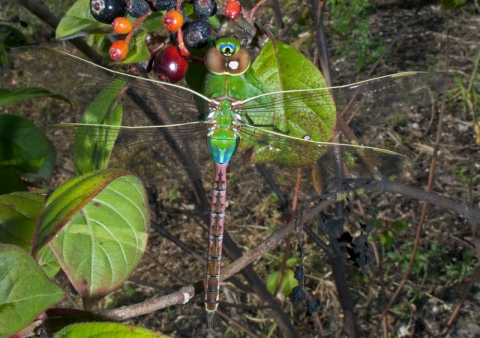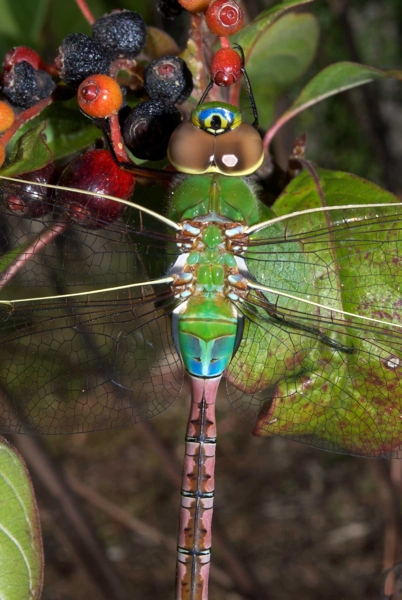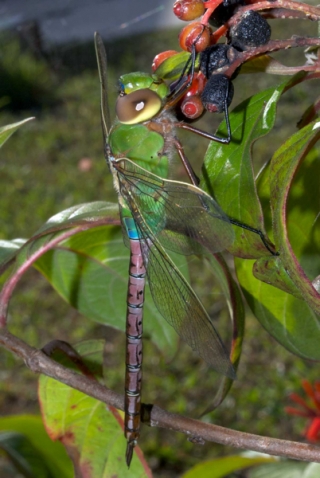A couple of years ago I was going through my photo files and ran across a picture of a pretty dragonfly, Anax junius, the common green darner. I had seen this darner on the trail at Fern Forest, and since I was posting about dragonflies at the time, I wrote a brief piece about it. But I prefer to post articles about the species I can see in my own back yard; if I have to travel, even if it’s just to a nearby nature center, it doesn’t feel like it’s as legitimate, somehow. But now I can write about A. junius to my heart’s content, because I found one hanging out (literally; most members of the Aeshnidae [darner] family don’t perch horizontally like other dragonflies, but hang vertically from their perches) in my Hamelia patens.
I found this guy by accident; I was actually trying to track down a tiny wasp, Pimpla marginella, to provide a better image than the only ones I’ve managed so far, and, although it’s another story, I encountered some (slight) success. As usual, the action happened between the two firebush shrubs I have side by side in a corner of the back yard. I had just finished taking the nearly successful shot of P. marginella on one of the shrubs when the tiny wasp flew away (as it does all too frequently, and always too soon!). When I turned around, I was startled to find this large, colorful dragonfly hanging vertically from a perch in the other bush, completely motionless and only about a foot away from me:
I immediately started taking pictures with the one lens I had, then went inside and grabbed my other lens, and when I came back out it was still there, and, what’s more, it allowed me to approach again and take more shots. The only sign of nervousness it betrayed at any point was a slight trembling, almost a shivering, of the forewings.
Needless to say, this is unusual.
Odonatologists separate dragonfly species into two broad groups based on how they regulate their body temperatures: perchers, which spend more time perching than they do flying, and hence gain their heat from basking in the sun, and fliers, which, one would assume, spend more time flying than they do perching, and use the heat they generate in flight to warm their bodies. (Corbet 1962, 126, appears to be the first description of this dichotomy.) Aeshnids, that is, darners, are fliers. (The distinction makes sense if you watch the perching behavior of the dragonfly in question: perchers hold their bodies out horizontally, so they’re ready to fly at a moment’s notice. But fliers hang vertically, which probably entails a bit more investment in the getting-into-flight process. Hence, they prefer to fly when they’re active, and “perch” when they’re not.)
Now, normally fliers are, shall we say, flighty creatures; I’m constantly frustrated by their refusal to allow close approach with my camera gear. In fact, that same day I had to resort to digiscoping a Tramea carolina (a so-called perching species) because I wasn’t able to approach it closely enough by any other means. But that, too, is another story.
Today’s story is about more than just a photo shoot of this most obliging individual, although it’s that as well. I also wanted to find out more about this species, since it’s such a striking one, and since it did me the favor of allowing me to stay so close to it for such a long time.
Here’s a close-up of the thorax, which contains the powerful flight muscles that propel this species through the air (at least when it’s not catatonic on my firebush!). You can also see the greatly enlarged first two abdominal segments (S1 and S2, the blue ones), and the constriction, or narrowing, behind S3 that is distinctive of most aeshnids:
If you look closely, you can see green bumps on the thorax, between the wings. These are NOT scale insects, even though they look like it to me, since I’ve been fighting those buggers every day for weeks now. They’re just rugosities on the exoskeleton, presumably sites of attachment of the flight muscles, although I’m not sure.
Here is some technical description of A. junius from Needham & Westfall (1955):
A large species, with green thorax and bluish abdomen. . . . Frons above with a rounded black or brown spot surrounded anteriorly by a yellow and then a blue semicircle. . . Abdominal segments 1 and 2 greatly swollen, their diameter being two or three times that of following segments.
The description of the yellow and blue semicircles on the frons is a bit technical; field guide authors (Paulson 2011) tend to be more succinct, calling it a “bullseye.” You can see it fairly well in the photo above that last quote.
And here it is in side view:
It stayed so still for so long, I was wondering if it had actually died, but its wings started to tremble and when I went back outside after reviewing the pictures on the computer, it had disappeared. I read later (Corbet 1962, 127) that these dragonflies are eocrepuscular, that is, most active at dusk and dawn, so perhaps the reason it was so still was that it hadn’t yet had its afternoon coffee. Corbet also notes (152) that these dragonflies, like another common backyard species, Pantala flavescens, can occur in large feeding swarms.
This dragonfly changes color according to the temperature; the male abdominal segments are typically blue, but when it’s cool out, they appear purple instead. The physiological mechanism that allows this is quite interesting, but beyond the scope of this simple blog.
In our area, this is a permanent resident, but in Canada, according to Corbet, writing in the 1950s, it appeared that the entire population is composed of migratory individuals; he concluded that their offspring,which emerge in August and September, all fly south shortly after emergence (Corbet 193).
Later writers have discovered that there are actually two groups of darner larvae in ponds in southern Canada; some are resident, while others are indeed migratory:
One group develops slowly, taking nearly a year to emerge as adults in the latter part of June or the first part of July. These adults remain in the vicinity and lay their eggs in late July and early August. The second group of larvae only requires three months to develop, from June to September. On emergence, the adults take wing and migrate from the area. Their offspring develop in a more southerly location, then begin to return the following year and start the cycle again. (Mitchell & Lasswell 2005)
The etymology of this taxon is elusive; according to the official list prepared by Dunkle and Paulson, the two deans of North American odonata (after Corbet), the derivation of the scientific name is unknown, while the common name refers to its “abundance and green thorax.” As I speculated in my post a couple of years ago, Anax means king, lord, chief, master in Greek, while junius is a bit less certain, but could very well be a straightforward nominative form of Iunius, which is Latin for June. That would make this species’ taxonomic name translate as “Lord of June,” which isn’t all that far-fetched. (Except that, if you check the bugguide data page for this insect, it’s absent from Florida in June and July!)
References
Corbet, P. S. (1962). A Biology of Dragonflies. Chicago: Quadrangle.
Corbet, P. S. (1999). Dragonflies: Behavior and Ecology of Odonata. Ithaca: Cornell UP.
Heinrich, B., and T. M. Casey (1978). Heat transfer in dragonflies: ‘fliers’ and ‘perchers’. J. exp. Bio. 74, 17-36.
Mitchell, F. L., and J. L. Lasswell. (2005). A Dazzle of Dragonflies. College Station, TX: Texas A&M U P.
Needham, J. G., and M. J. Westfall. (1955). A Manual of the Dragonflies of North America (Anisoptera). Berkeley: U of California P.
Paulson, D. R. (2011). Dragonflies and Damselflies of the East. Princeton UP.
Paulson, D. R. & S. W. Dunkle. (2009). A Checklist of North American Odonata, Including English Name, Etymology, Type Locality, and Distribution. Originally published as Occasional Paper No. 56, Slater Museum of Natural History, University of Puget Sound, June 1999.




Hello Ben,
I am Paige and I am currently working on an Anax junius informational website project for my Animal Biology class. I would like to know if you would give me permission to use your images of the Anax junius from your webpage. This website that I am creating will be on the internet forever because it would be informing the public about this species. My website will be located at MultipleOrganisms.net. Also, I would cite you and your website as the source of this picture. By clicking on the image, a new window will open up to this website. Please reply as soon as possible on this website. Thank you for your time.
Hi, Paige.
Yes, you may use the Anax junius images from this web page for your project. Please let me know when your site is available for viewing!
–Ben
Hi Ben,
Thank you very much for your permission. The website should be up this weekend! The website URL is https://bioweb.uwlax.edu/bio210/s2012/boley_paig/.
– Paige
Spotted the Anax junius yesterday, May 10th 2012, in central Virginia. Probably male. I’ve never seen the dragonfly before. The internet says “Common” green darner. Is this guy really so common?
You know, that’s a good point. In most animals (I’m thinking especially of birds like Kentucky or Cape May Warbler), the common name is often very misleading. Philadelphia Vireos are NOT particularly common in Philadelphia. But dragonfly common names are of much more recent origin, and the people who came up with them (Dennis Paulson and Sid Dunkle) tried to come up with fairly logical names. The Common Green Darner is in fact very common: it’s the most widespread and common odonate species in North America.
But as the automakers always had to add to their ads in the 1980s: your mileage may vary. Like you, I don’t find the Common Green Darner anywhere near as often as I find other species (I saw literally hundreds of Halloween Pennants yesterday, and didn’t see a single “common” darner). Part of that could be that your particular habitat might not be as attractive to them as it is to other species, and if dragonflies find an ecological niche already occupied, they probably don’t hang around very long. Or it could just be random chance.
In any case, thanks for stopping by; hope you enjoy the articles!